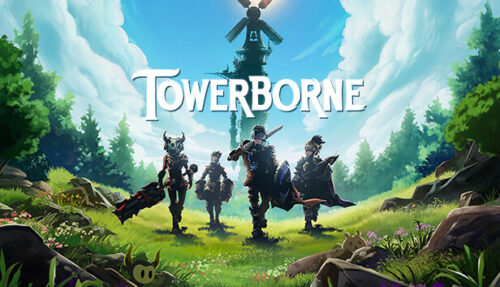Towerborne Preview
Hybrid-genre games are nothing new. However, for developers, they remain a slightly risky proposition. Blending genres in a way that makes sense and balances the mechanics is easier said than done. It’s easy for ideas to feel inorganically bolted on. Towerborne, Stoic’s new blend of action RPG and side-scroller beat-‘em-up, seems to get the recipe just right. What I’ve played so far is a pretty tasty dish.
While there’s a wealth of backstory, characters, and narrative in Towerborne, the premise is simple. The land is overcome by monsters released in a cataclysm. The last refuge for the people is The Belfry, a towering storybook structure that rises over the once bucolic landscape. You play as an Ace, a hero with a thousand lives. The Belfry reminds me of one of those fanciful structures you construct in a chill city-builder. It’s absurdly tall and there are humble houses improbably circling the outside. Inside, you’ll find the staples of action adventures, like quest givers, vendors, and an odd and/or inspiring cast of NPCs. Because Towerborne is a multiplayer game at heart, The Belfry is also a social hub.
While an action game doesn’t live or die by its art, Towerborne’s visual style is captivating. The lush landscapes are the stage for cel-shaded characters and flashy combat with a lot of captivating melee and magic effects. It’s conceptually not too distant from Stoic’s Banner Saga series. This time, lead artist Arnie Jorgensen has infused the game with fewer muted colors and much more vibrant characters. While we’re talking aesthetics, composer Austin Wintory has partnered with Stoic again to write the score, and it’s a winner. It’s a bit of a hybrid between pastoral, folkish-sounding motifs and late 19th-century romanticism. Music for the game’s action combat is refreshingly free of pounding percussion.

Combat at Heart
Narrative effectiveness and memorable characters aside, the game’s combat is at the core of Towerborne. It immediately feels unique. It mostly consists of waves of low-level enemies, escalating to more elite foes and, of course, a boss. In true beat-’em-up style — think Streets of Rage 4, for example — there isn’t a lot of downtime. You clear an area, scroll a little further to the right and you’re in the thick of combat again.
Characters in Towerborne move between foreground, middle, and background lanes, fighting enemies that do the same. The only issue I had with this was that quite often, groups of enemies would attack in little parallel packs, making it hard to distinguish any one foe. My other minor complaint about the combat was that precise turning to face an enemy felt a bit clunky and slow.
If that’s all there was to combat, Towerborne would feel pretty shallow. However, this is where the game’s satisfying RPG systems come into play. There are four classes: Sentinel, Pyroclast, Rockbreaker, and Shadowcaster. Each one comes with specific weapon types, skills, and special attacks. Players can switch freely between classes. They all play differently and cater to traditional RPG preferences like melee, magic or ranged. The game’s mix of historical and fantasy elements allows for a mix of spells, swords, and gunpowder.
No One is Alone
The developers have noted that Towerborne can be played solo. In all honesty, though, this can be a bit of a slog. For one thing, there are a lot of enemies, attacking from many directions. Having a squad of players, each with a different class, is ideal. This allows for a perfect, rock-paper-scissors approach to fighting a variety of monsters. It also helps break up the pack and solves that problem of parallel groups. It would be great if players could switch classes on the fly. Unfortunately, this can only be done outside combat.

However, solo players aren’t at a total loss. For one thing, the game scales to the number of players. For another, players have a magical creature ally called an Umbra. Each Umbra has offensive or defensive abilities, like stunning an enemy or healing. Combining a specific class with a complementary Umbra is key.
I played Towerborne in a preview version, so not every feature was unlocked and there were still a few rough edges. Towerborne enters Early Access on PC and Xbox with a $24.99 price tag, though I believe the final release will be free-to-play with a cash shop for mostly cosmetic items.
Road Map to Fun
Towerborne has a colorful and immediately appealing art style and an excellent musical score. But its big draw is the action RPG/beat-’em-up combat, which looks to have both a great deal of Early Access content and the possibility for endless expansion and iteration. Towerborne is a departure from Stoic’s Banner Saga trilogy, but continues the developer’s tradition of making interesting, unique, and engaging games.
Thank you for keeping it locked on COGconnected.

